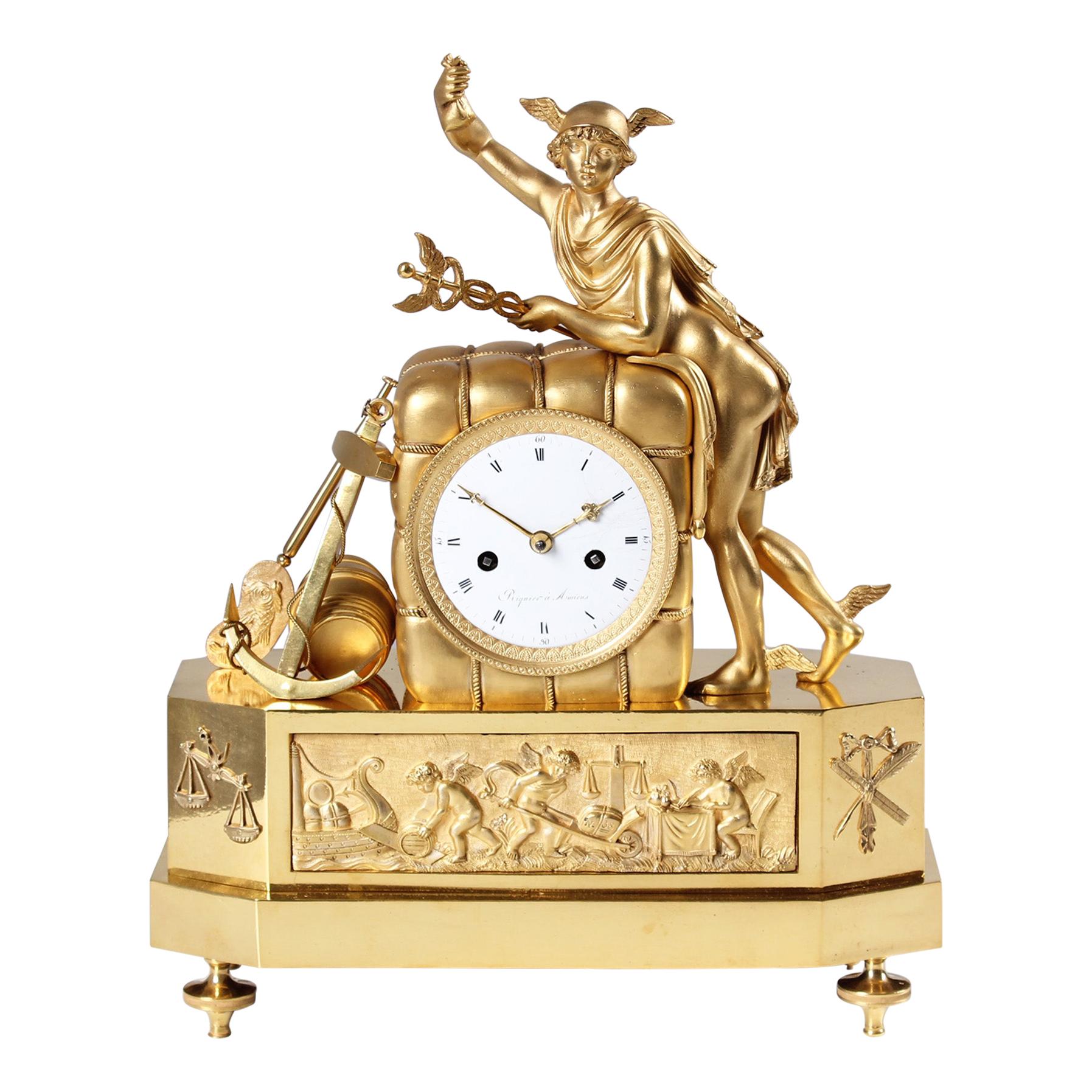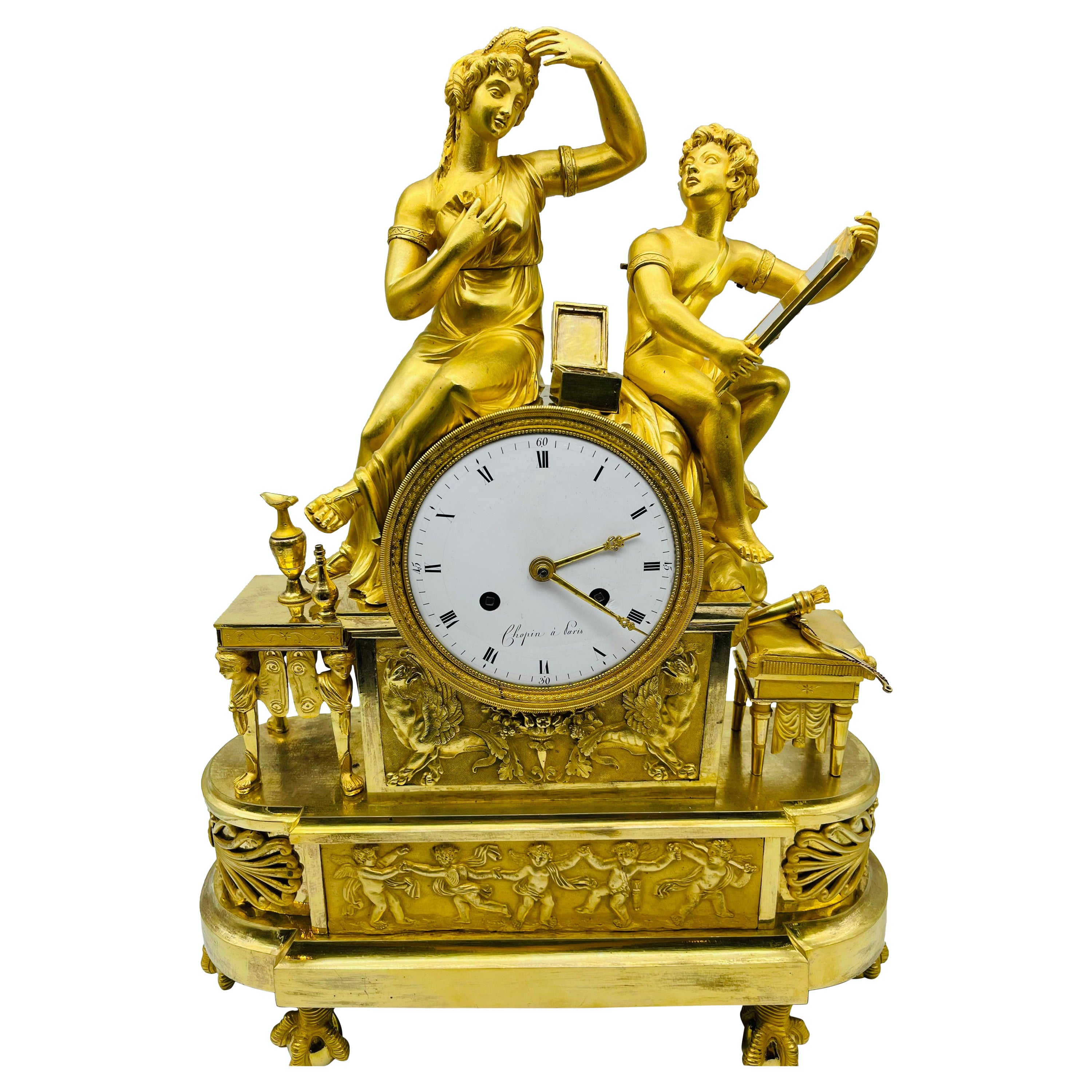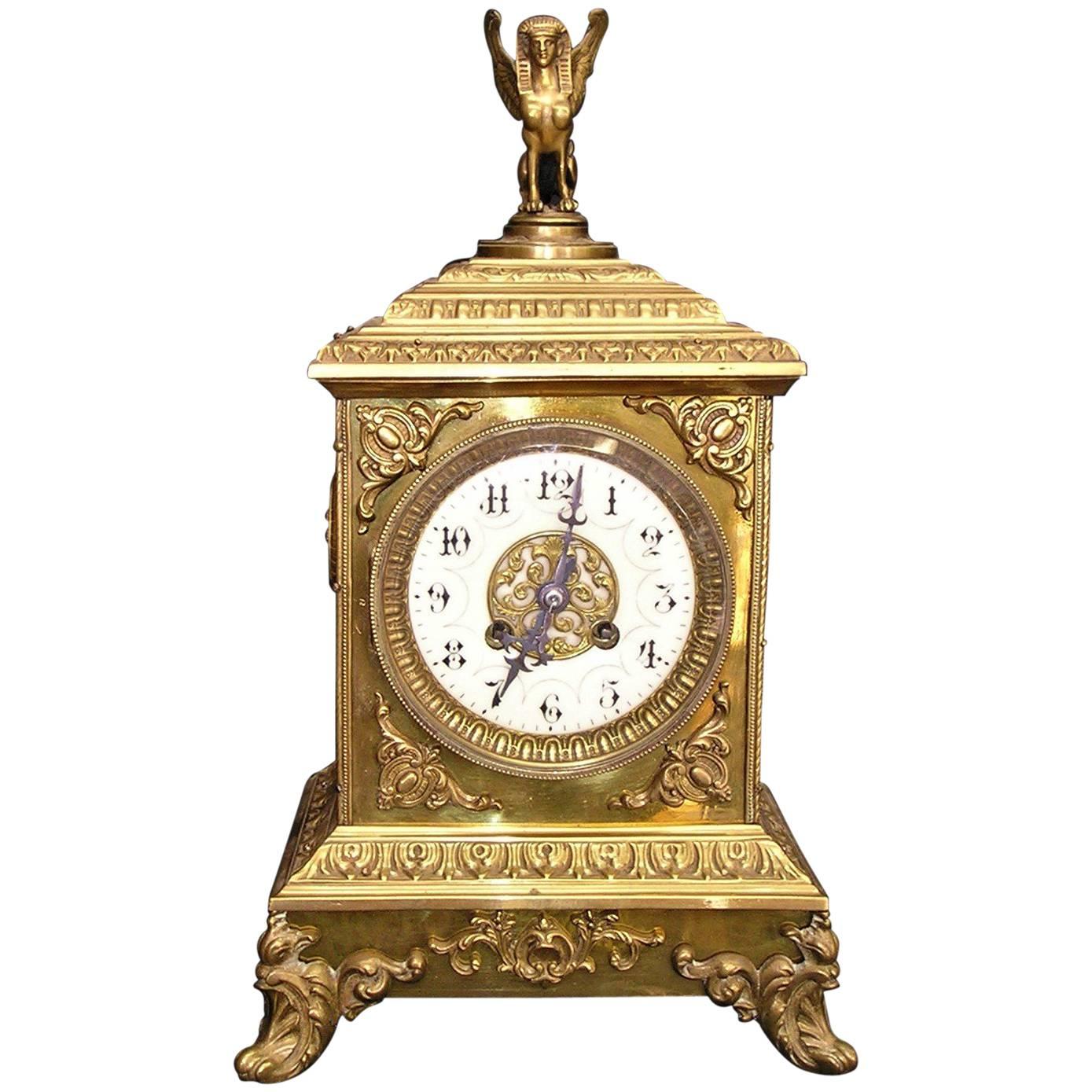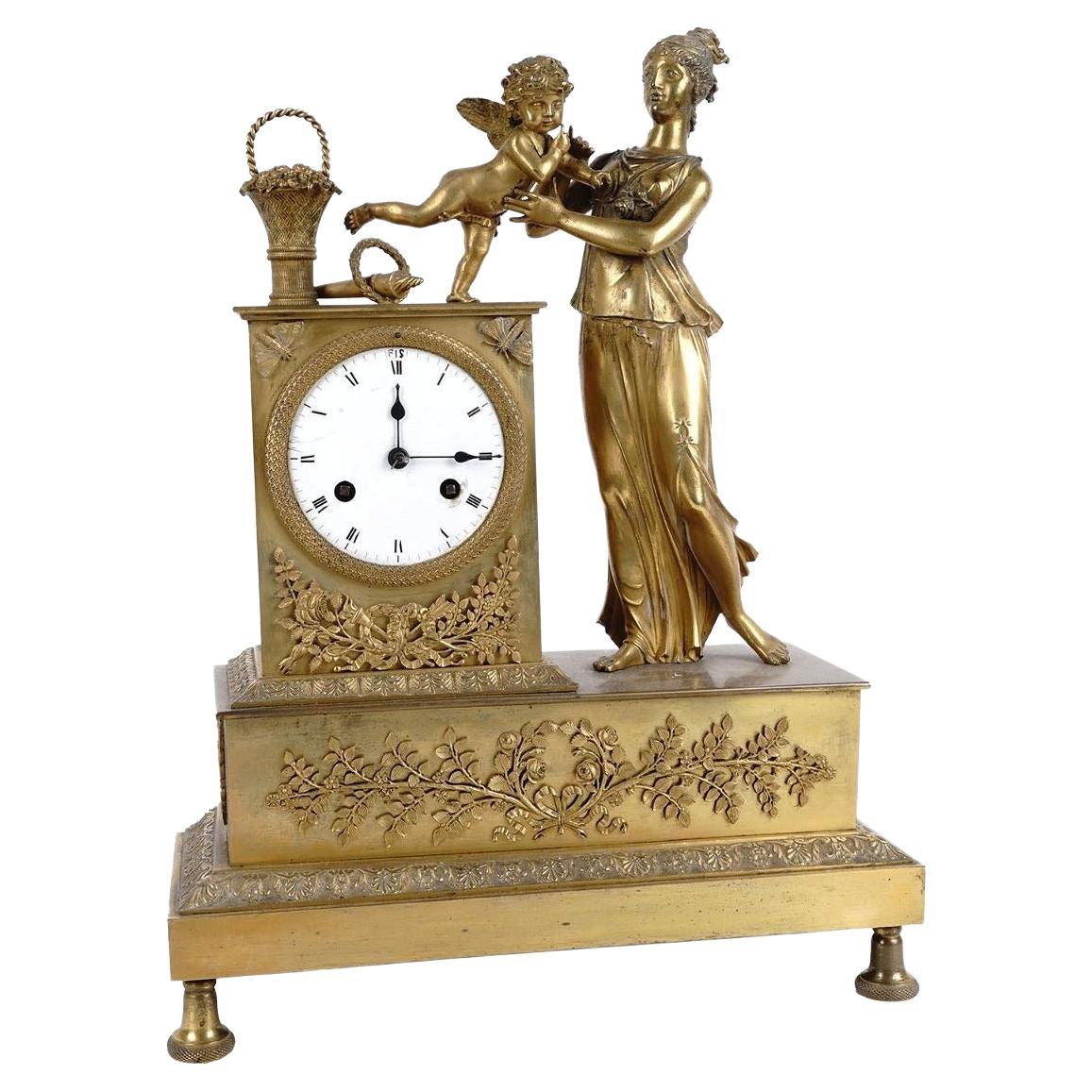Items Similar to French Empire Ormulu Bronze Mantel Clock, Lepaute, Thomire, Paris, circa 1815
Video Loading
Want more images or videos?
Request additional images or videos from the seller
1 of 20
French Empire Ormulu Bronze Mantel Clock, Lepaute, Thomire, Paris, circa 1815
About the Item
Ormulu pendule with depiction of friendship and love
Paris (Lepaute, Thomire)
fire-gilt bronze
Empire around 1815
Dimensions: H x W x D: 44 x 36 x 13 cm
French pendulum movement with eight days duration. Thread suspension and lock disc striking movement with strike on bell on the half and full hour.
White enamel dial with Roman hour numerals and Breguet hands.
Signature: LePaute & Fils / Hrl. du Roi (Pierre-Basile Lepaute (1750 - 1843) with his son Pierre-Michel Lepaute (1785-1849); from 1811 in joint workshop).
Description:
The extremely high quality pendulum shown here takes up a profound theme: Friendship, which combines with love and can thereby outlast time and death. As it is typical for the epoch of classicism, personifications and symbols are taken from the fund of ancient mythology and art and then developed further.
The main figure is a young woman in an antique, girded garment, standing barefoot and with crossed legs next to an altar, on which she is leaning with her left elbow. She gracefully bows her head towards a tempestuously approaching Cupid, grasps his right hand with her left and draws him to her bosom, the seat of the heart. The delicate ambivalence of flying towards and being held culminates in the trustingly intimate look that the two cast at each other.
The young woman personifies friendship, the winged Cupid love. As a sign of their intimate connection, two burning hearts appear on the altar next to the two, framed by the puffed scarf, which are closely bound together by a chain of flowers.
Next to them, on the altar slab, one can see an erected book with the title "Amitie" (French: amitie, friendship). Supporting the book is a pomegranate held by a ring of pomegranate flowers. The bursting seeds spill out of the cracked skin. Since ancient times, the pomegranate and its blossoms have been dedicated to the goddess Persephone, symbolizing the underworld and death, but also life and fertility. The myrtle interwoven in the pomegranate flower wreath of "friendship" also has a far-reaching symbolic power: the plant was dedicated to the goddess Aphrodite, stands for virginity, and was and is therefore obligatory in the bridal wreath. Above all, it means love and fidelity beyond death.
The dimension of infinity is also indicated by the inscription "HIVER, ETE" at the top of the young woman's headband. "Winters as well as summers" the friendship lasts, thus also beyond death.
This is also indicated by the figure of Chronos in the relief field below the dial. The god of time is depicted in accordance with the ancient language of forms as an old, but muscular-athletic man with a strong beard and powerful wings - time "flies". In his left hand he holds a large scythe with which he cuts off all life. Unusually, however, he also clutches a bow with quiver and arrows in his right arm. As he strides hastily to the right, he looks cautiously to the left, as if he thought he was being followed. In fact, he would have every reason to do so, for the bow and arrow originally belong to Cupid, the god of love. They are his weapons feared by men and gods. For with the burning arrows of love he strikes the hearts of men and injures them severely. This kind of love wounds the heart, it combines passion with desire, sexuality, jealousy, pain, loss. A Cupid deprived of these weapons would be the one, ideal love that overcomes physicality and transience.
This is exactly the kind of love we see here in the form of the now disarmed Cupid flying to the heart of friendship to join it.
For French art, the theme of the transformation of passionate love into loyal soul friendship is directly and exemplarily connected in the figure of Madame de Pompadour (1721 - 1764), who was the official mistress of the French king Louis XV for over 20 years and also one of the cleverest and most powerful women of her time. But in 1750, the love relationship with the king is transformed into a friendship relationship. In accordance with the necessary legitimization of this change of role before court and society, she commissioned the most important artists to create allegorical sculptures.
Thus, in 1758, Jean-Baptiste Pigalle created the marble group "Love embraces friendship", which can be seen as a direct model for the bronze of the pendulum shown here, especially the intimate connecting gaze of the two, but also the flowers and the vine-covered elm trunk (left and right above the dial).
But not only the imagery and composition of the bronze group are outstanding. Both the fineness of the casting and the original fire gilding and varied chasing show the highest quality.
This is particularly evident in the bas-relief of Chronos: here the background is chiseled in a granular manner, while the wings reveal each individual feather. The body is chiseled in such a way that the surface accentuates the shimmering parts of the muscles, making it look exceedingly three-dimensional. As a literal highlight, individual areas, such as the edges of the fluttering cape, are highly polished and brilliantly reflect the light.
The quality of this bas-relief, which stands out only slightly from the surface and yet produces an astonishing plasticity, represents a high level of sculpture.
Although the bronze is not signed - like almost all pendulums of this period - the composition and the quality of the figures, the bronze work, the gilding and the chasing allow to consider for this Pierre-Philippe Thomire (1751 - 1843). The most important broncier of the Empire is proved to have worked more often with the Horloges Lepaute (Lit. Augarde, pp. 352-354).
A particular quality feature of the artwork is the integration of the original movement with the white enamel dial into the iconography of the bronze. It embodies sensually real through the hour indications and hands, but also through its ticking, the unstoppable progress of time. This progression is physically pictured by the dynamic chronos of the bas-relief below. In contrast, the dead elm tree with the vividly entwining vine leaves remind us of the constancy within the passage of time.
Overall, this bronze pendulum with its thoughtful and finely executed composition is a perfect symbol of an ideal, loving friendship that transcends all time.
Fun Facts:
The Horloges of the Lepaute family form their own dynasty in Paris with outstanding workshops. They have held the honorable title of "Horloger du Roi" (Watchmaker to the King) since 1751, the reign of the French King Louis XV. This continued under Louis XVI and, after the end of the Bourbon kings with the Revolution of 1789, under Emperor Napoleon I (1805 - 1814). Pierre Basile Lepaute and his son Pierre Michel now receive the title of "Horloger de l'Empereur" (Watchmaker to the Emperor).
Even after the end of the Napoleonic Empire, they kept their privileged position in the following period of the Restoration, when the Bourbon kings were enthroned again: in 1814, they became "Horloger du Roi" for the Bourbons Louis XVIII (1814 - 1824) and and Charles X (1824 - 1830).
Throughout their creative period, the watchmakers of the Lepaute family were commissioned with works not only by the royal court, but by the entire high aristocracy. Following the high demands of their clients, they collaborated with the most important sculptors and bronciers, among others P.-P. Thomire, R. Osmont, F. Vion and Clodion. Accordingly, their pendulums can be found in the most important castles, collections and museums of the world.
Condition:
Excellent condition of the movement as well as the original fire gilding.
The price includes an expertise written and signed by Dr. Elke Niehüser. Most of the above description is taken from this comprehensive expertise.
Comparable objects can be found in the following literature:
Jean-Dominique Augarde - Les Ouvries du Temps p.351-353
H. Ottomeyer / P. Pröschel - Gilded bronzes p. 343-346
Elke Niehüser - The French Bronze Clock
Tardy - Dictionaire des Horlogers Francais p. 384
Gravelot / Cochin - Iconologie par Figures (23) AMITIÉ.
- Dimensions:Height: 17.33 in (44 cm)Width: 14.18 in (36 cm)Depth: 5.12 in (13 cm)
- Style:Empire (Of the Period)
- Materials and Techniques:
- Place of Origin:
- Period:
- Date of Manufacture:1815
- Condition:Wear consistent with age and use. Excellent condition of the movement as well as the original fire gilding.
- Seller Location:Greven, DE
- Reference Number:1stDibs: LU5419228058572
About the Seller
5.0
Platinum Seller
These expertly vetted sellers are 1stDibs' most experienced sellers and are rated highest by our customers.
Established in 2014
1stDibs seller since 2020
119 sales on 1stDibs
Typical response time: <1 hour
- ShippingRetrieving quote...Ships From: Münster, Germany
- Return PolicyA return for this item may be initiated within 14 days of delivery.
More From This SellerView All
- 19th French Empire Mantel Clock, Pendule, Mercury, Gilded Bronze, circa 1815Located in Greven, DE19th century French pendule, mantel clock - Mercury the messenger of the gods France Bronze gilded Empire around 1815 Dimensions: H x W x D: 37 x 30 x 10 cm Description: French Empire...Category
Antique Early 19th Century French Empire Mantel Clocks
MaterialsBronze
- Empire Mantel Clock - La Bibliotheque, Ormolu, France, Paris, circa 1820By Le RoiLocated in Greven, DEMantel Clock - La Bibliotheque - In the study room Paris fire-gilt bronze, enamel Empire around 1820 Dimensions: H x W x D: 38 x 28 x 19 cm Description: Scenery mounted on an oval...Category
Antique Early 19th Century French Empire Mantel Clocks
MaterialsBronze
- Early 19th Century Mantel Clock, Firegilt Bronze, Paris circa 1810Located in Greven, DEVery rare "Au Bon Sauvage" mantel clock France Fire-gilt and patinated bronze Empire around 1810 Dimensions: H x W x D: 34 x 41 x 13 cm Description: Extremely rare French bronze m...Category
Antique Early 19th Century French Empire Mantel Clocks
MaterialsBronze
- Early 19th Century Ormolu Mantel Clock, Atala freeing Chactas, Paris, circa 1810Located in Greven, DEMantel Clock "Atala and Chactas" Paris Bronze (fire-gilt and patinated), enamel Empire around 1810 Dimensions: H x W x D: 40 x 32 x 11 cm Description: Very rare and extremely high quality French mantel clock, so-called Pendule Au Bon Sauvage. Depicted are scenes from the love story "Atala or the love of two savages in the desert" written by Francois René Vicomte de Chateaubriand in 1801. At the beginning of the 19th century, this was probably the most famous love story in Europe, but today it has been forgotten. The story, set in present-day Louisiana (USA), is roughly rewritten about the forbidden love between Chactas, a young Indian, and Atala, the beautiful daughter of a Spaniard. Chactas is captured in a battle between two Indian tribes, chained to a palm tree and is to be sacrificed. Atala wants to save his life and convert him to Christianity. She unties him from the palm tree at night and they flee together into the wilderness of North America. Their love for each other grows stronger and stronger and they have prospects for a future together. The story takes a tragic turn when Atala, who must remain a virgin due to a vow made by her mother, can no longer withstand the conflict of her feelings and commits suicide. The main group of characters thus shows Chacta's liberation through Atala. Atala is leaning against a pile of logs. The animal fur thrown over the logs and the weapons leaning against the stack on the right give the impression of a night camp. The bronze is of rarely beautiful quality, finely chiselled and makes the scene appear very lively. The contrast of fire-gilded and patinated bronze adds tension to the composition. In the base we see the Entombment as the end of the tragic love story. This bronze work is also very detailed, the interplay of bright and matt gilding makes the flat relief appear much deeper than it is. The depiction of the mantel clock presented here shows that the exotic was only known from stories and that the bronzier had his own ideas about the appearance of this distant world. The Indian, for example, has very European facial features and his skin was not black in reality, of course. The palm tree was also certainly not found in the North American wilderness. The heart of the clock is a French pendulum movement, integrated into the wooden pile, with an eight-day power reserve and a lock plate striking a bell on the half and full hour. The pendulum is suspended on a thread, typical of the period. The classically shaped hands, so-called Breguet hands, are also typical of the time. The enamelled dial has black Roman hour numerals, Arabic quarter hours and bears the signature: Le Roy hr. de Madame A PARIS. Interesting facts: The period from 1795 to about 1815 saw the creation of probably the most spectacular group of bronzes: The "Au bon Sauvage" pendulums - depictions of the "Noble Savage". Today's viewers react to these objects with both fascination and irritation. Enthusiastic on the one hand about the obvious quality of the detailed bronzes and the allure of the exotic, on the other hand distanced and cautious because of the possible discrimination that is suspected behind them. The ambivalence of this feeling motivates the search for the conditions of origin of these pendulums. Europeans found their new ideal of the natural man primarily in fictional and realistic travelogues about the Indians of North America...Category
Antique Early 19th Century French Empire Mantel Clocks
MaterialsOrmolu
- 19th Century Miniatur Mantel Clock, Gare La Bombe, Cupido, France, Gilded BronzeLocated in Greven, DEPendulette "Gare La Bombe" France gilded bronze first half 19th century Dimensions: H x W x D: 20 x 15 x 7 cm Description: Antique miniature mante...Category
Antique Early 19th Century French Empire Mantel Clocks
MaterialsBronze
- 19th Century Mantel Clock "Astronomy", France circa 1830Located in Greven, DEAntique mantel clock on the theme of astronomy France Bronze Charles X around 1830 Dimensions: H x W x D: 48 x 19 x 10 cm Description: Unusual and beautifully crafted bronze mante...Category
Antique 19th Century French Charles X Table Clocks and Desk Clocks
MaterialsBronze
You May Also Like
- French Empire Period Ormolu Bronze Mantel Clock of Ceres, circa 1815Located in Shippensburg, PAEMPIRE ORMOLU BRONZE FIGURAL MANTEL CLOCK OF CERES, GODDESS OF AGRICULTURE Movement by Etienne Tavernier; France, circa 1815 Item # 104HWG22Z A fine Empire period mantel clock with bun feet raising a rectangular base with a central portrait of Bacchus flanked by exquisitely chiseled motif of swirling foliage surmounted by a figure of the goddess Ceres grasping in her lowered hand a wreath woven with foliage and berries while in her garment she collects a bountiful harvest; she rests beside the clock tower with a framed lens opening to access the white enamel dial with black Roman numerals inscribed Etn. Tavernier set with Breguet style hands, raising an urn filled with fruits of the soil; against the tower rest the implements of labor, a shovel and flat rake. The movement is engraved "B". A significant clock movement maker, Etienne Tavernier (French, 1756-1839) is listed in Tardy's horology reference as working closely with the house of Abraham-Louis Breguet as well as providing clock movements...Category
Antique 19th Century French Empire Mantel Clocks
MaterialsBronze, Ormolu
- Antique French Empire Style Ormolu Bronze 'Ceres' Mantel Clock, After ThomireBy Pierre-Philippe ThomireLocated in Madrid, ESFollowing a model by early 19th century Paris sculptor and bronzier Pierre-Philippe Thomire, and showcasing many of the neoclassical design elements common to the Empire Style popula...Category
Antique 19th Century French Empire Mantel Clocks
MaterialsBronze
- Royal Empire Mantel Clock / Pendulum Clock, Fire-Gilt, Around 1805-1815, ParisLocated in Berlin, DERoyal Empire mantel clock / pendulum clock, fire-gilt, around 1805-1815, Paris Solid bronze, fire-gilded, Paris around 1805-1815, original French Empire from the first period. ...Category
Antique Early 1800s French Empire Mantel Clocks
MaterialsBronze
- French Empire Style Bronze Mantel ClockLocated in Hamilton, OntarioFrench Empire style bronze mantel clock.Category
Antique 19th Century French Empire Mantel Clocks
MaterialsBrass, Bronze
- French Empire Ormolu Bronze Mantel ClockLocated in New York, NYAntique (early 19th century) French ormolu bronze mantel clock in the Empire style depicting neoclassical maiden with child.Category
Antique 19th Century French Empire Mantel Clocks
MaterialsBronze
- French Empire Ormolu and Patinated Bronze Mantel Clock Signed Vaillaint a ParisLocated in London, GBSuperb quality French Empire ormolu and patinated bronze mantel clock in a beautifully restrained case. The casting and gilding of the finest quality. A classically dressed maiden st...Category
Antique Early 1800s French Empire Mantel Clocks
MaterialsBronze, Ormolu





